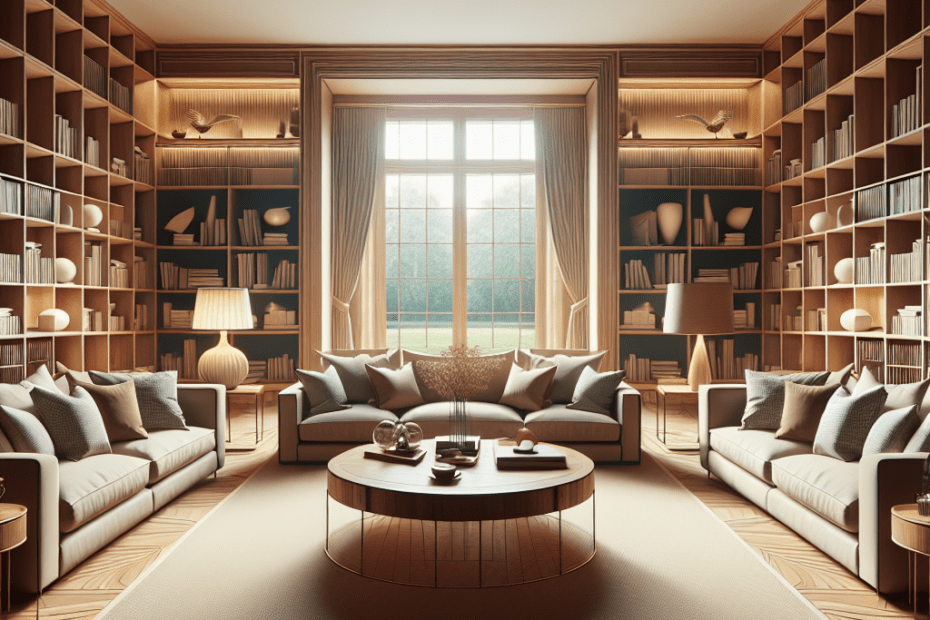“`html
The Power of Symmetry in Living Room Design
When stepping into a room that feels balanced and cohesive, one might wonder what design principles create such harmony. Many interior designers agree that symmetry plays a pivotal role in achieving this effect. Symmetry in living rooms isn’t just about matching furniture pieces, but also about crafting a sense of order and tranquility.
In today’s world, where our homes have become sanctuaries away from the chaos outside, people are searching for ways to make their living spaces as calming as possible. According to a report from Houzz, 45% of homeowners sought to improve their home’s ambiance, with many turning to symmetric designs for a timeless, grounded appeal. This makes designing with symmetry not just a choice, but a trend worth understanding.
Elements of Symmetry in Living Rooms
Symmetry in living rooms can manifest in various ways, each contributing to a cohesive aesthetic. Here’s how they can incorporate symmetry into their space:
- Matching Furniture – Placing two identical sofas facing each other can create a central axis, forming the backbone of a symmetrical layout.
- Bookcases and Cabinets – Pairing bookcases or cabinets on either side of a fireplace or main artwork is a classic way of introducing balance.
- Artwork and Decor – Utilizing pairs of lamps, vases, or art pieces amplifies spatial harmony. An artwork or mirror positioned directly above a mantle can serve as a focal point, with matching pieces on either side.
These elements not only enhance the room’s beauty but also facilitate a layout conducive to conversation and relaxation.
The Psychological Impact
Humans naturally find symmetrical spaces more pleasing. This preference is rooted in the way their brains process visual information, favoring order over chaos. Symmetry can reduce stress levels and evoke tranquility, making a symmetric living room an ideal space for unwinding.
Research by Devlin et al. (2019) found that rooms with symmetrical layouts were perceived as more organized and less cluttered, enhancing the overall comfort of the space. Such findings indicate that symmetry isn’t just about aesthetics but also impacts users’ well-being.
Statistics on Symmetry in Home Design
The trend towards symmetry isn’t limited to anecdotal evidence. Several studies and surveys provide concrete numbers about how and why symmetry influences modern design choices:
| Statistic | Source |
|---|---|
| Over 60% of designers prioritize symmetry for living room layouts. | Interior Design Society Annual Report, 2022 |
| 45% of homeowners favored symmetrical layouts to enhance relaxation. | Houzz Home Survey, 2023 |
| Rooms perceived as 30% more spacious with symmetrical arrangement. | Home Aesthetic Review, 2021 |
Practical Tips for Creating Symmetry
For those looking to incorporate symmetry in their living rooms, here are a few practical steps they can consider:
- Identify the Center Point – This could be a fireplace, TV, or a large window. The room’s layout should radiate from this focal feature.
- Use Pairs – Purchase items like armchairs or end tables in pairs to immediately give a sense of balance.
- Color Coordination – Symmetrical color schemes further emphasize unity. Utilize contrasting colors for interest but ensure they harmonize across the space.
- Scale and Proportion – Ensure that the items on each side of the room are of similar size to prevent emphasis from shifting off-center.
Key Takeaways
- Symmetry in living rooms fosters balance, inviting tranquility and cohesion.
- Implementing symmetry involves thoughtful placement of furniture, decor, and color schemes around a focal center.
- Studies show symmetric designs enhance perception of spaciousness and reduce stress.
FAQs on Symmetry in Living Rooms
- What is the easiest way to create symmetry in a living room?
Starting with pairs of furniture and decor pieces, like sofas and lamps, directly contributes to a symmetric design.
- Can symmetry work in small living rooms?
Yes, symmetry can make a small space feel more structured and organized, often giving the illusion of a larger area.
- Is symmetry always necessary in design?
While symmetry offers numerous benefits, they can also explore asymmetry for a more dynamic and modern approach.
- What color schemes work best in a symmetric design?
Monochromes or complementary colors are best, focusing on balance. Neutral tones with soft accents further enhance symmetry.
- How can symmetry impact mental well-being?
Studies suggest that symmetric spaces reduce stress and enhance relaxation, creating an inviting atmosphere.
“`
